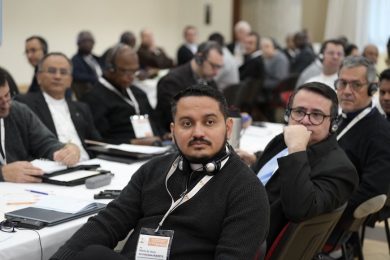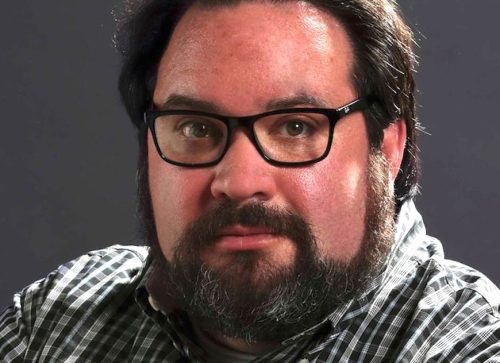By Beth Griffin | OSV News
YONKERS, N.Y. (OSV News) — The church is deeply divided on fundamental truths including marriage, sin and the nature of the Eucharist, but there is a path to unity through dialogue, humility and a focus on shared baptism, according to Catholic theologian Charles Camosy.
“The sheer number of massive disputes and scandals testifies to how difficult it is to foster unity in the universal church even among people who have so much in common,” he said. This is not a special or unprecedented age of division, but it does not need to devolve into a “left versus right polarized fight to the death,” Camosy added. “The Holy Spirit is still very much guiding the church” and there is “real hope” of progress toward the unity envisioned by Christ, ‘that all may be one,'” he said.
Camosy, the Michael J. Curran Fellow in Moral Theology at St. Joseph’s Seminary and College in Yonkers, gave a Feb. 16 address at the school on “One Church: Best Practices for Resisting Catholic Polarization.”
“Sometimes unity comes from the most unlikely times and places,” Camosy said. As an example, he said the Focolare lay apostolic movement was founded during the Allied bombing of Italy during World War II. Focolare uses the Holy Trinity as a model of unity in diversity and works to achieve it through dialogue and encounter, which also is the basis for Camosy’s strategy of best practices to overcome polarization.

“Dialogue within the church is very much like ecumenical work with those who practice other religions,” he said. It should begin with a loving response to the dignity of the human person and build on the foundation of a common baptism. “We are literally brothers and sisters,” and there can be healthy disagreements within families, he said.
There must be a commitment to listen actively to one another with humility. While it is tempting to see someone as a “thin caricature” of extreme positions, it is important to learn and understand the “thick story” of a person’s actual experience, he said.
In dialogue, parties should “lead with what you’re for, rather than merely what you’re against,” Camosy said. “If you can find agreement, it makes it increasingly clear where your disagreements are.”
This helps people achieve “authentic disagreement,” which goes beyond an emotional response and can support an actual calm argument between people who have developed trust in one another, he said.
Camosy acknowledged his principles and strategies are sometimes difficult to execute and may not work in every instance, but they can be employed in exchanges with fellow Catholics to foster unity in diversity.
The people Camosy calls “Spirit of Vatican II Boomers” might be thinly caricatured as “old, out of touch and with a played-out agenda,” he said. But their “thick story” includes the gift of being “in-their-bones Catholics who lit the fire, passed on the faith, never totally let go,” and personally experienced the Holy Spirit working in the church.
For those in conflict with the “Spirit of Vatican II Boomers,” a dialogue with them might look at the texts of the Vatican II documents to appreciate their focus on current themes such as the role of Catholic laity and skepticism of clericalism. The Holy Spirit is at work and there is serious common ground to be found, he said.
People who don’t relate to the group Camosy calls, “Traditional Millennials,” might find common ground with them by appreciating that traditional liturgical practices, such as Eucharistic Adoration, are highly resistant to the “techno individualistic phone culture” and give young people an embodied sense of community and belonging in an atomized world, he said.
“If we truly believe that God’s grace is working through the church, we must put aside our limited understanding and personal preferences, and pay attention to the new things God is doing,” Camosy said, “even when they seem counterintuitive and push us in directions we weren’t expecting.”
The exchange and dialogue he proposes can be deeply uncomfortable and painful, Camosy said, but with the right attitude can also be joyful, life-giving and exciting. He said, “Indeed, it may be best understood as a Christian adventure that requires us to cast out in the deep and lower our nets.”






















